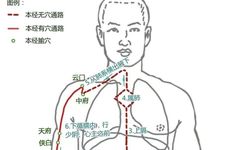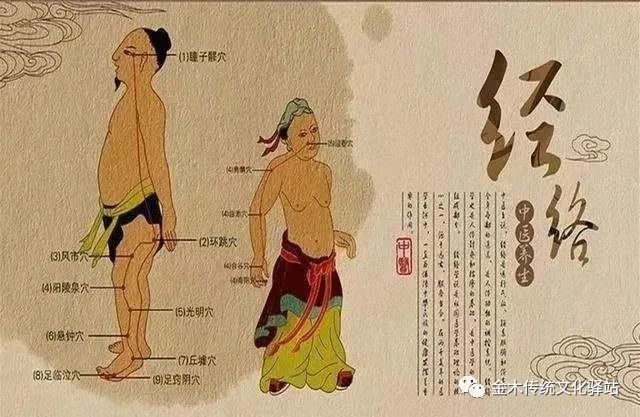
1. Lung Hand Taiyin Meridian (肺手太阴之脉) – 11 Points
“Ling Shu – Jing Mai”: The Lung Hand Taiyin Meridian originates in the middle jiao, connects to the large intestine, and follows the stomach, ascending to the diaphragm and belonging to the lung. It emerges from the lung system, traverses under the armpit, descends along the inner arm, travels to the heart, descends to the elbow, follows the inner arm along the bone, enters the cun (寸) point, ascends to the fish (鱼) point, follows the fish margin, and exits at the tip of the thumb.
Its branch emerges from the back of the wrist, directly going out along the inner margin of the index finger, exiting at its tip.
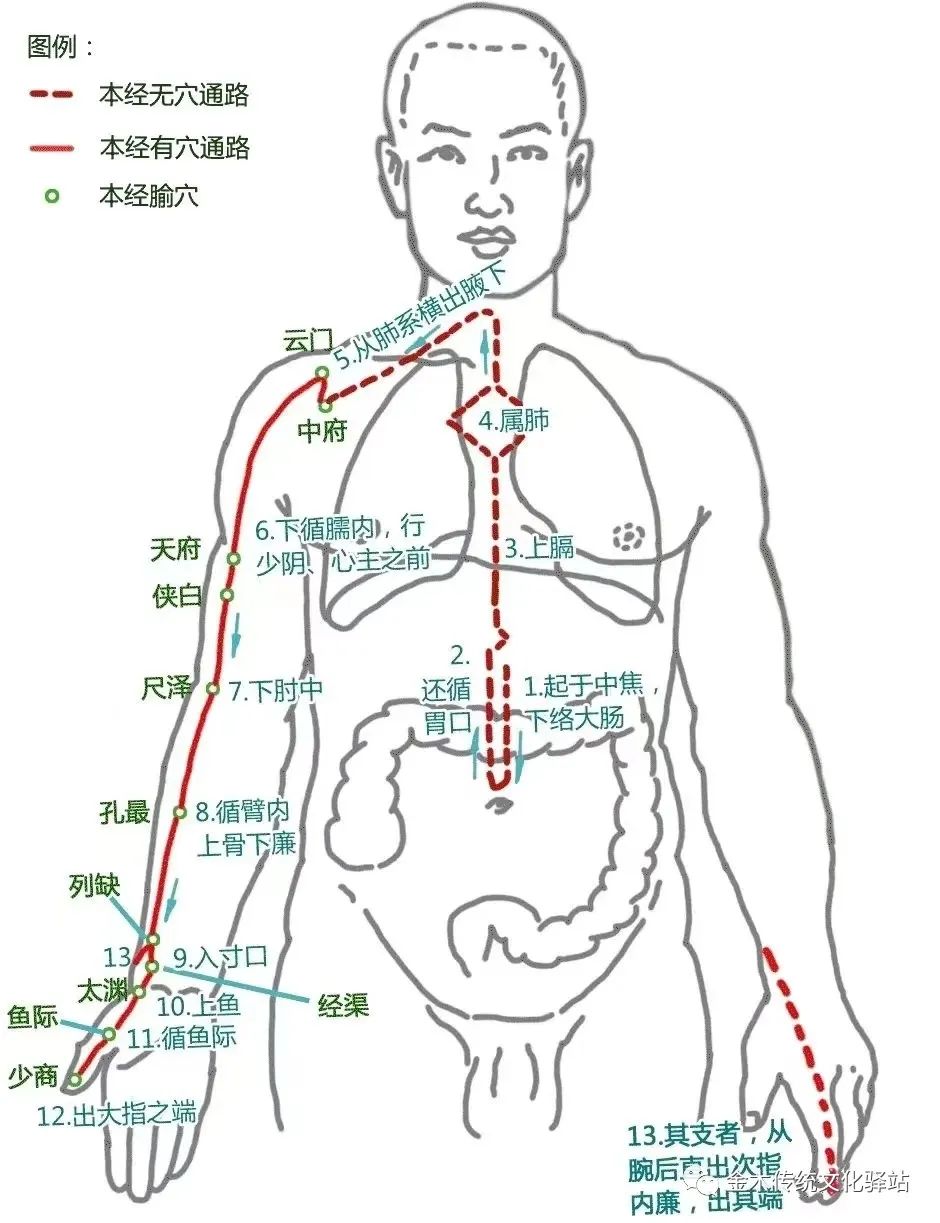


2. Large Intestine Hand Yangming Meridian (大肠手阳明之脉) – 20 Points
“Ling Shu – Jing Mai”: The Large Intestine Hand Yangming Meridian originates at the tip of the thumb and index finger, follows the outer margin of the fingers, enters between the two bones of He Gu (合谷), ascends between the two tendons, follows the outer margin of the arm, enters the outer elbow, ascends the outer shoulder, exits in front of the acromion, ascends to the upper part of the shoulder, descends into the chest, connects to the lung, descends to the diaphragm, and belongs to the large intestine.
Its branch emerges from the chest, travels up the neck, enters the cheek, and connects to the lower teeth; it also exits beside the mouth, crossing the philtrum—left to right, right to left, entering the cheek, and ascending to the nostrils.
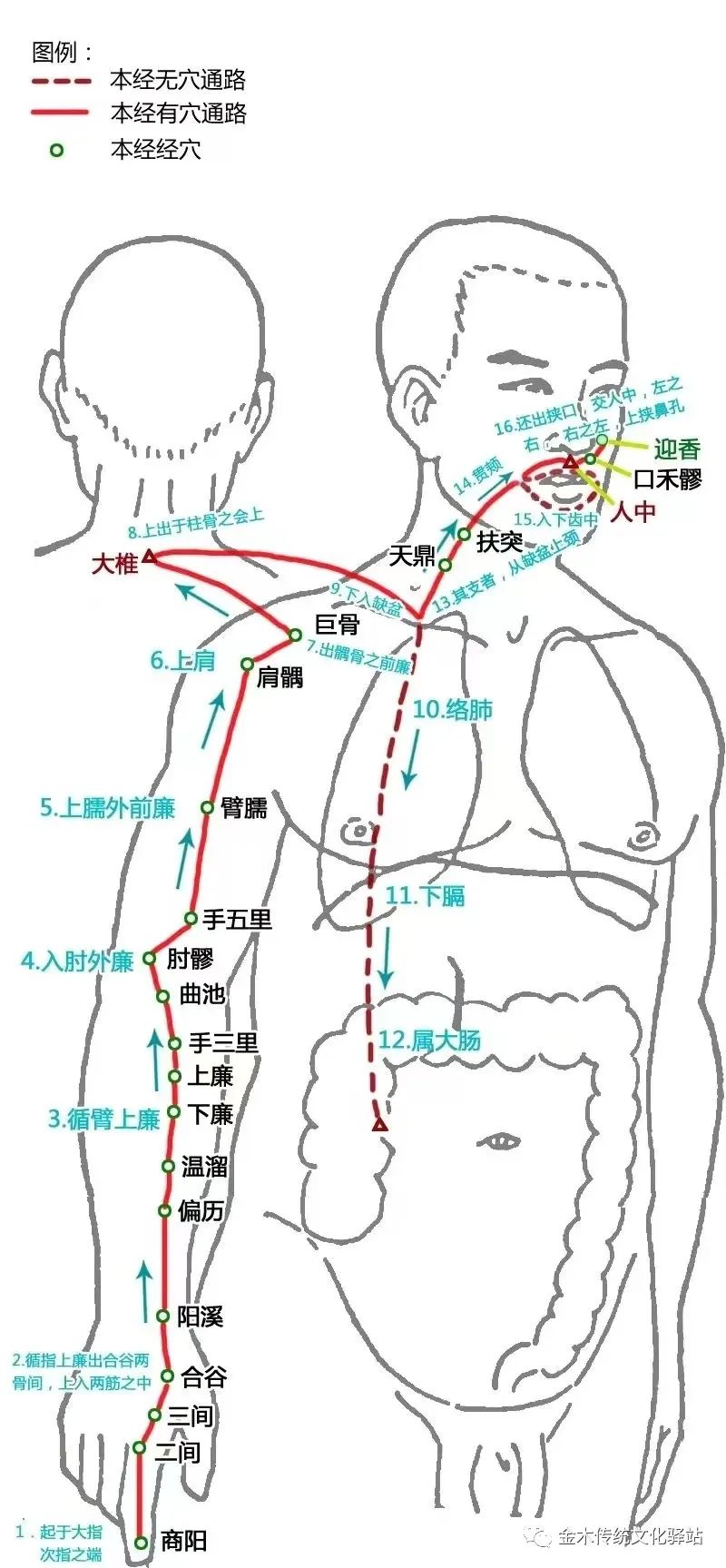

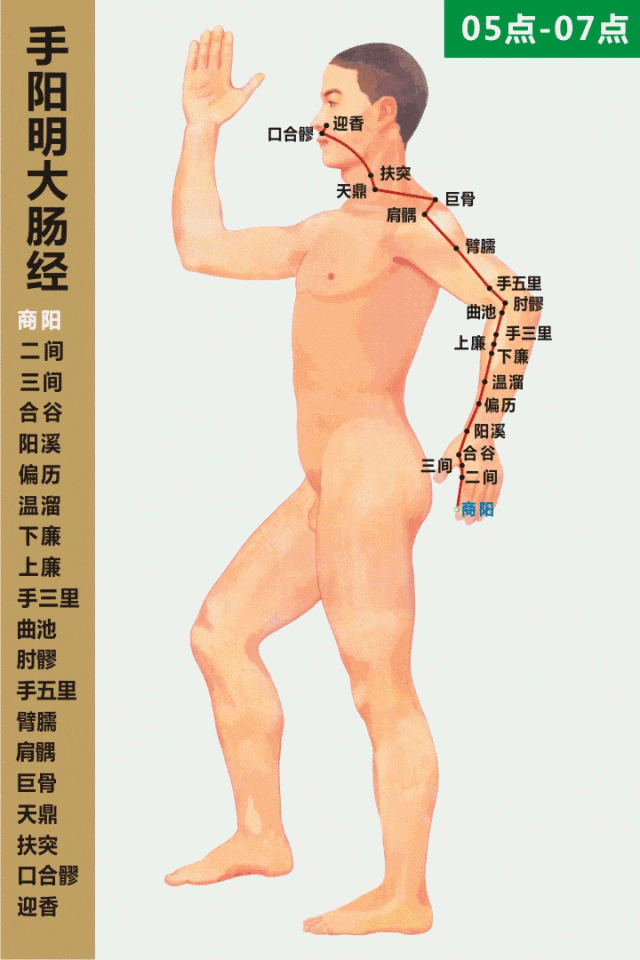
3. Stomach Foot Yangming Meridian (胃足阳明之脉) – 45 Points
“Ling Shu – Jing Mai”: The Stomach Foot Yangming Meridian originates at the nose, intersects at the bridge of the nose, descends along the outer side of the nose, enters the upper teeth, exits beside the mouth, encircles the lips, descends to Cheng Jiang (承浆), follows the jawline, exits at Da Ying (大迎), follows the cheekbone, ascends in front of the ear, passes the temple, follows the hairline, and reaches the forehead.
Its branch emerges from Da Ying, descends to Ren Ying (人迎), follows the throat, enters the chest, descends to the diaphragm, belongs to the stomach, and connects to the spleen.
Its direct branch descends from the diaphragm, along the inner margin of the breast, descends beside the navel, and enters the Qi Jie (气街) area.
Its branch separates three cun below the knee, entering the outer margin of the middle finger.
Its branch separates at the top of the foot, entering between the big toe and second toe, exiting at its tip.

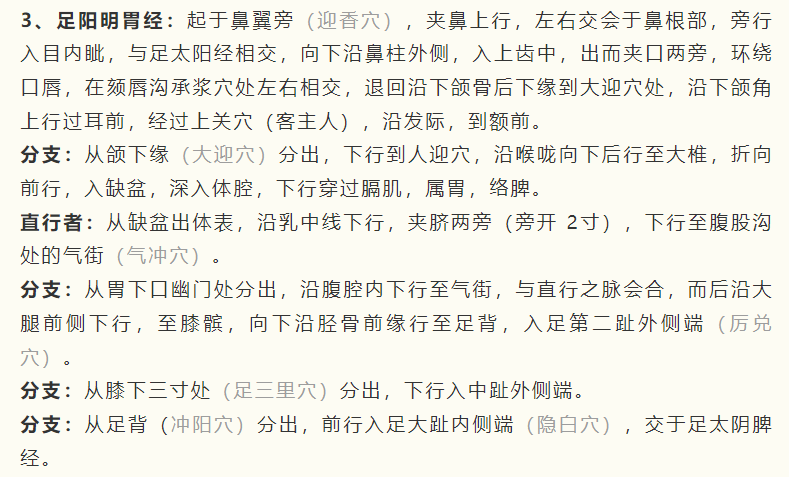
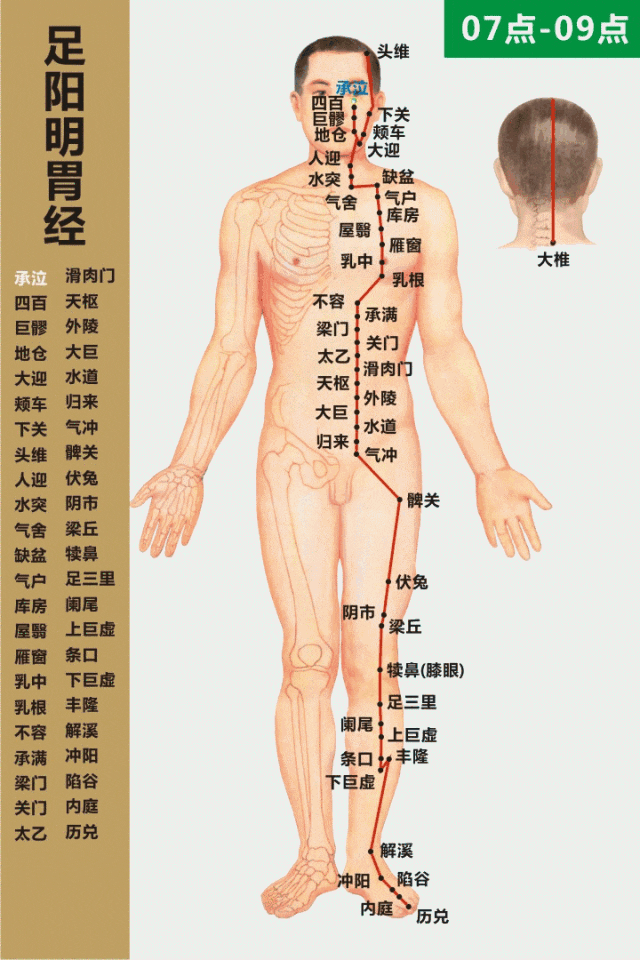
4. Spleen Foot Taiyin Meridian (脾足太阴之脉) – 21 Points
“Ling Shu – Jing Mai”: The Spleen Foot Taiyin Meridian originates at the tip of the big toe, follows the inner side of the toe, passes behind the navicular bone, ascends in front of the inner ankle, follows the inner side of the tibia, intersects before the Jueyin (厥阴) point, ascends along the inner front of the knee, enters the abdomen, belongs to the spleen, connects to the stomach, ascends to the diaphragm, encircles the throat, connects to the root of the tongue, and disperses under the tongue.
Its branch separates from the stomach, ascends to the diaphragm, and enters the heart.
The major branch of the spleen, called the Great Bao (大包), emerges three cun below the armpit, spreading across the chest and ribs.
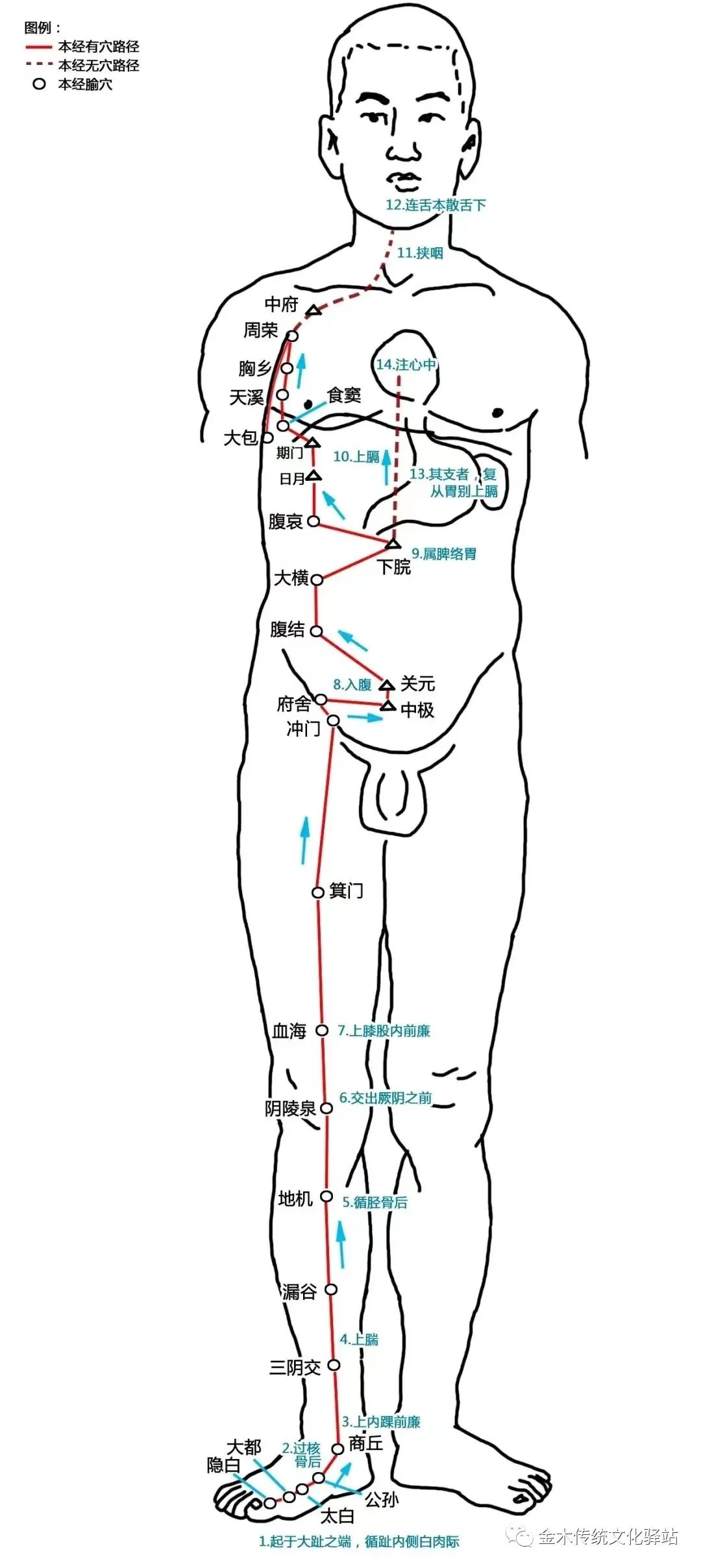

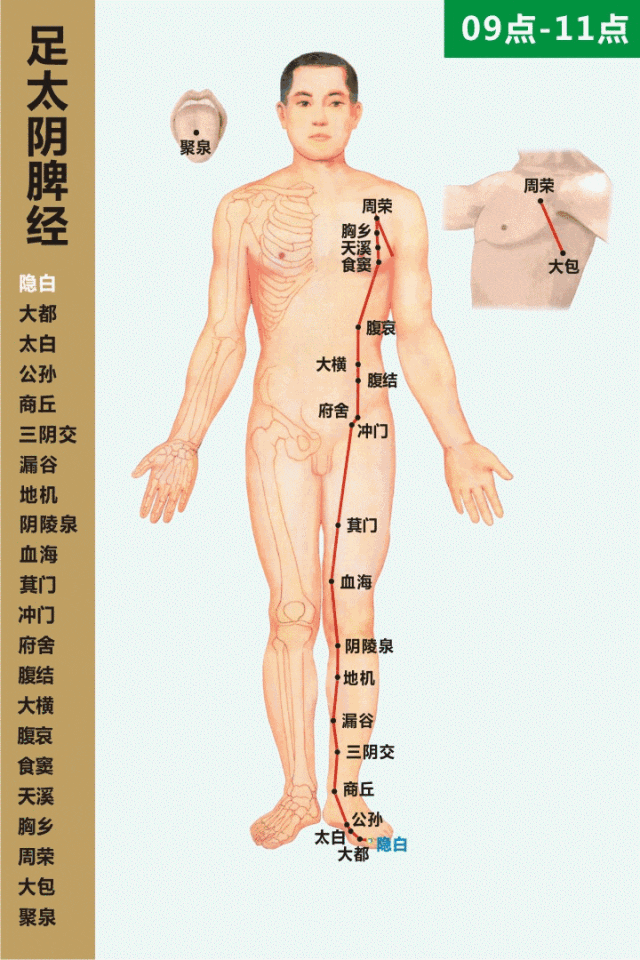
5. Heart Hand Shaoyin Meridian (心手少阴之脉) – 9 Points
“Ling Shu – Jing Mai”: The Heart Hand Shaoyin Meridian originates in the heart, emerges from the heart system, descends to the diaphragm, and connects to the small intestine.
Its branch emerges from the heart system, ascends beside the throat, and connects to the eye system.
Its direct branch emerges from the heart system, ascends to the lung, descends under the armpit, follows the inner back of the arm, travels behind the elbow, descends along the inner back of the arm, reaches the tip of the palm, enters the palm, follows the inner side of the little finger, and exits at its tip.


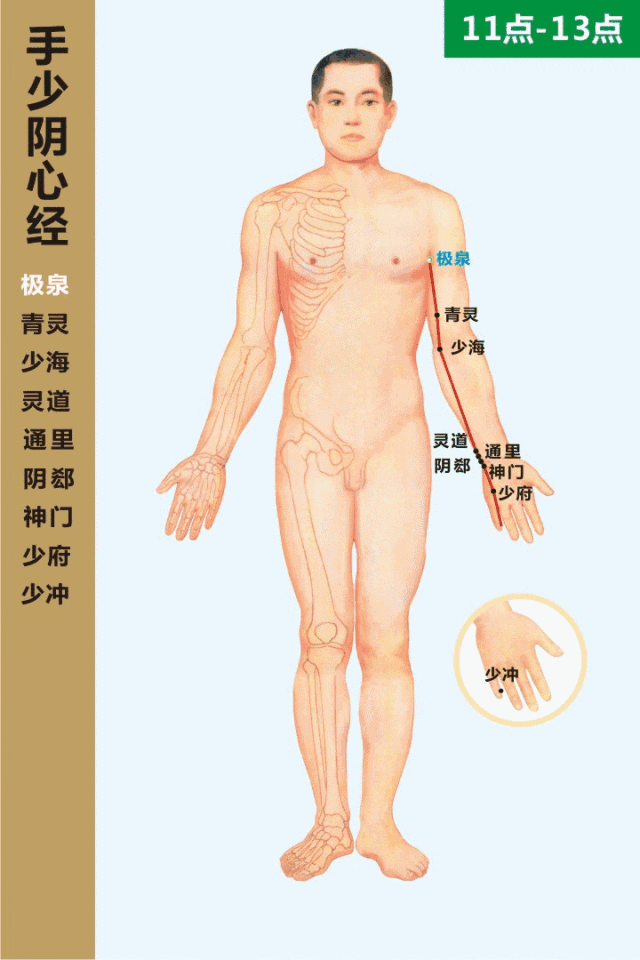
6. Small Intestine Hand Taiyang Meridian (小肠手太阳之脉) – 19 Points
“Ling Shu – Jing Mai”: The Small Intestine Hand Taiyang Meridian originates at the tip of the little finger, follows the outer side of the hand, exits at the middle of the ankle, ascends along the outer side of the arm, exits between the two bones of the elbow, ascends along the outer back of the arm, exits at the shoulder, encircles the shoulder blade, intersects at the shoulder, enters the diaphragm, connects to the heart, follows the throat, descends to the diaphragm, and belongs to the small intestine.
Its branch emerges from the diaphragm, follows the neck, ascends to the cheek, and enters the ear.
Its branch separates at the cheek, reaches the nose, and ascends to the inner corner of the eye, obliquely connecting to the cheekbone.



7. Bladder Foot Taiyang Meridian (膀胱足太阳之脉) – 67 Points
“Ling Shu – Jing Mai”: The Bladder Foot Taiyang Meridian originates at the inner corner of the eye, ascends to the forehead, and intersects at the crown.
Its branch ascends from the crown to the upper corner of the ear.
Its direct branch enters the brain, exits and separates at the nape, follows the inner shoulder, descends along the spine to the waist, enters the lumbar region, connects to the kidney, and belongs to the bladder.
Its branch descends from the waist, follows the spine, penetrates the buttocks, and enters the popliteal fossa.
Its branch separates from the shoulder, descends along the spine, passes the hip joint, follows the outer back of the thigh, descends to the popliteal fossa—below the knee, exits behind the outer ankle, follows the bone to the outer side of the little toe.
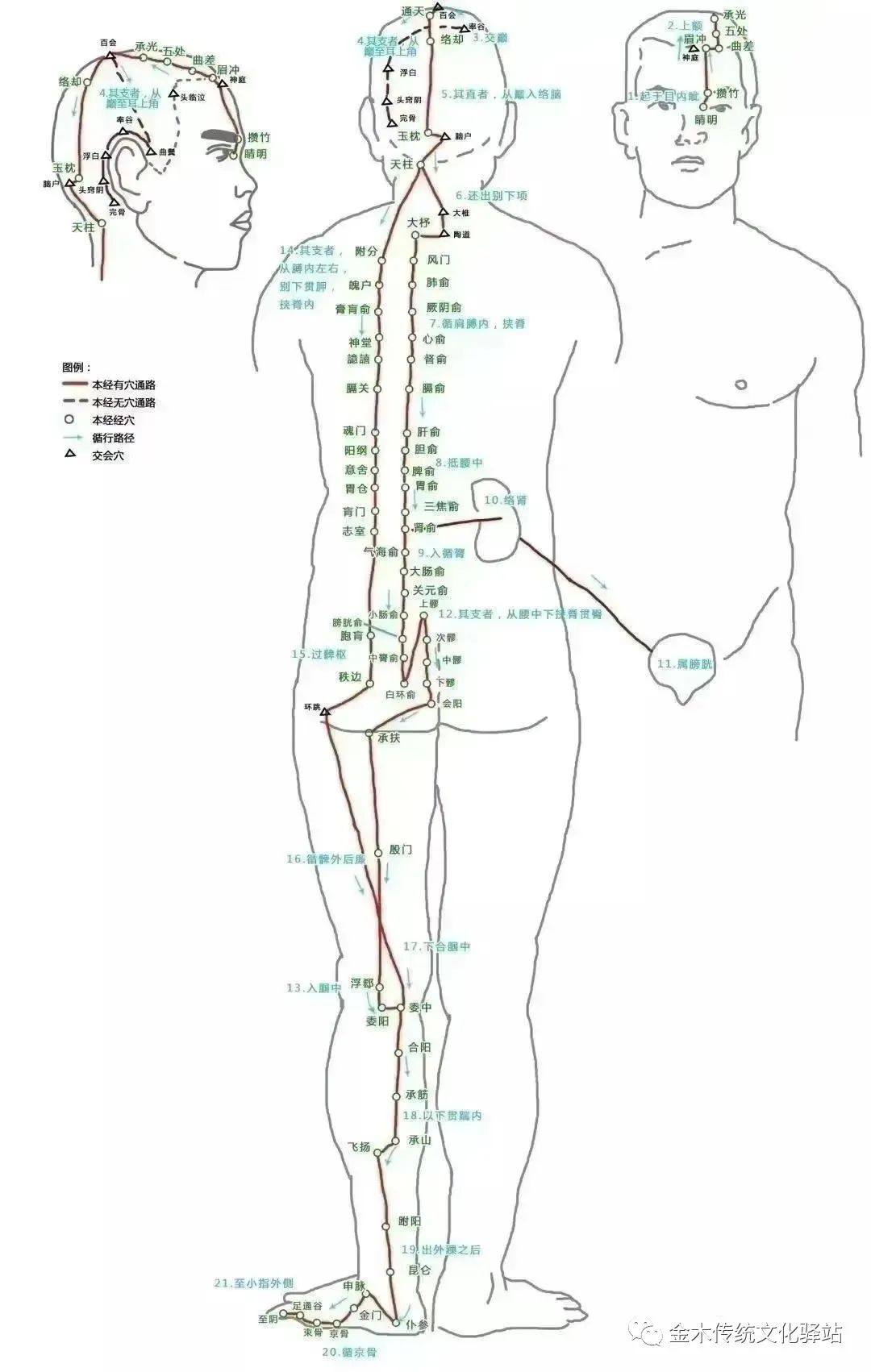
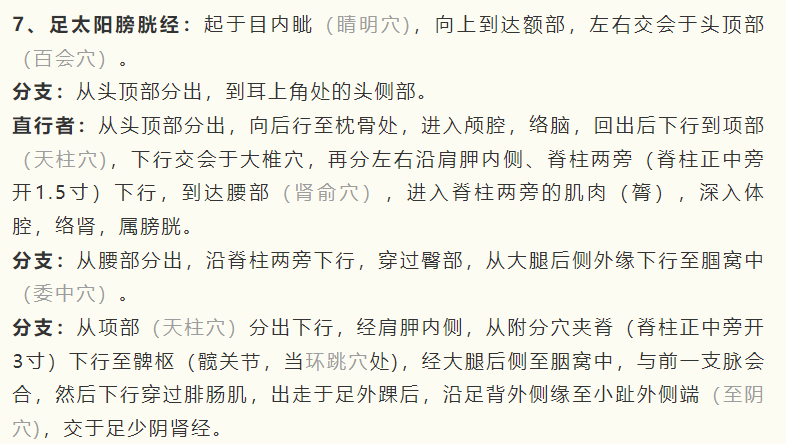

8. Kidney Foot Taiyang Meridian (肾足太阳之脉) – 27 Points
“Ling Shu – Jing Mai”: The Kidney Foot Shaoyin Meridian originates below the little toe, travels through the sole of the foot, exits below the heel, follows the inner ankle, enters the heel, ascends along the inner thigh, enters the spine, connects to the kidney, and links to the bladder.
Its direct branch ascends through the liver diaphragm, enters the lung, follows the throat, and connects to the root of the tongue.
Its branch emerges from the lung, connects to the heart, and enters the chest.
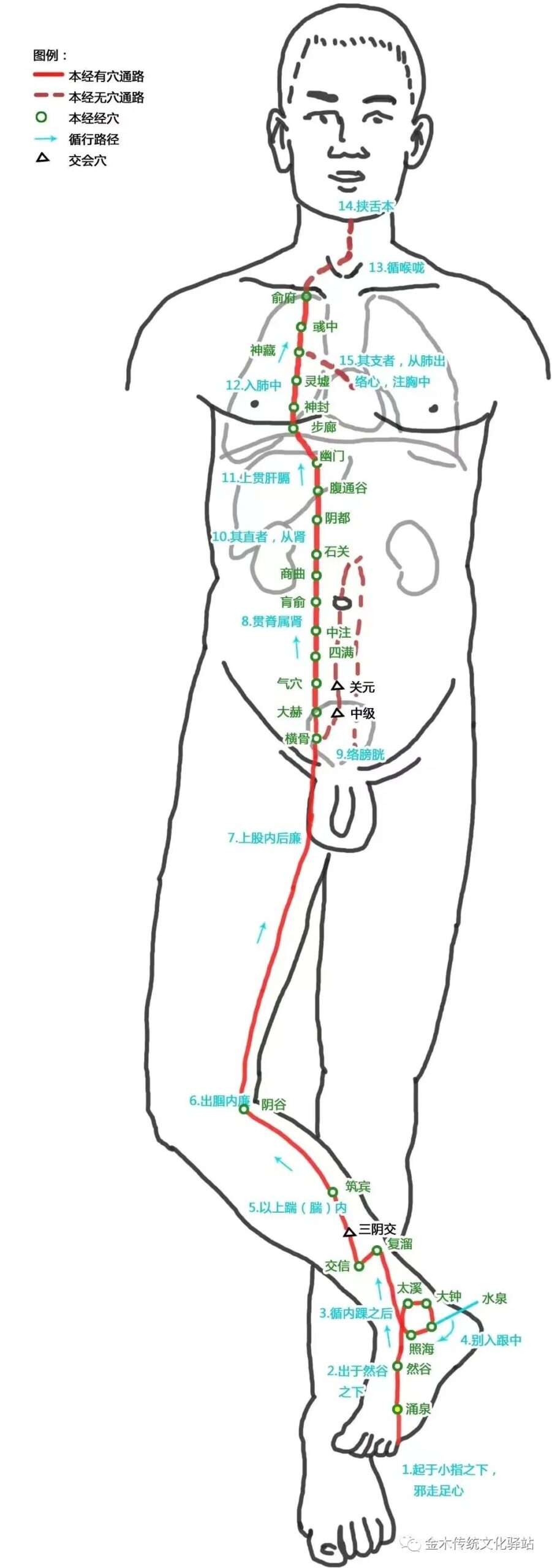

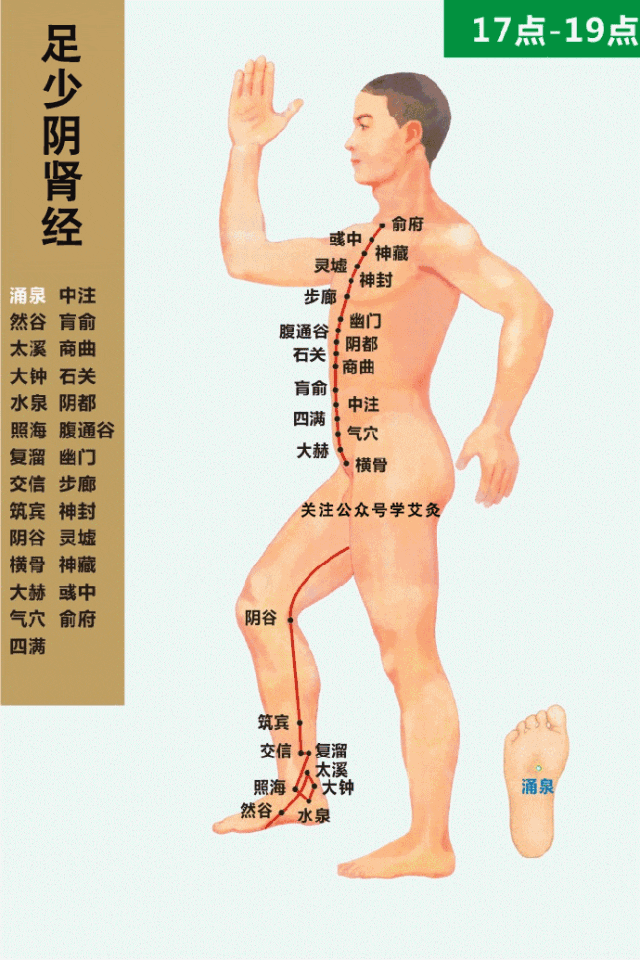
9. Pericardium Hand Jueyin Meridian (心包手厥阴之脉) – 9 Points
“Ling Shu – Jing Mai”: The Pericardium Hand Jueyin Meridian originates in the chest, emerges from the pericardium, descends to the diaphragm, and traverses the three jiao (三焦).
Its branch follows the chest, exits the ribs, descends three cun below the armpit, ascends to the armpit, follows the inner arm, travels between the two tendons, enters the palm, follows the middle finger, and exits at its tip.
Its branch separates from the palm, follows the little finger, and exits at its tip.
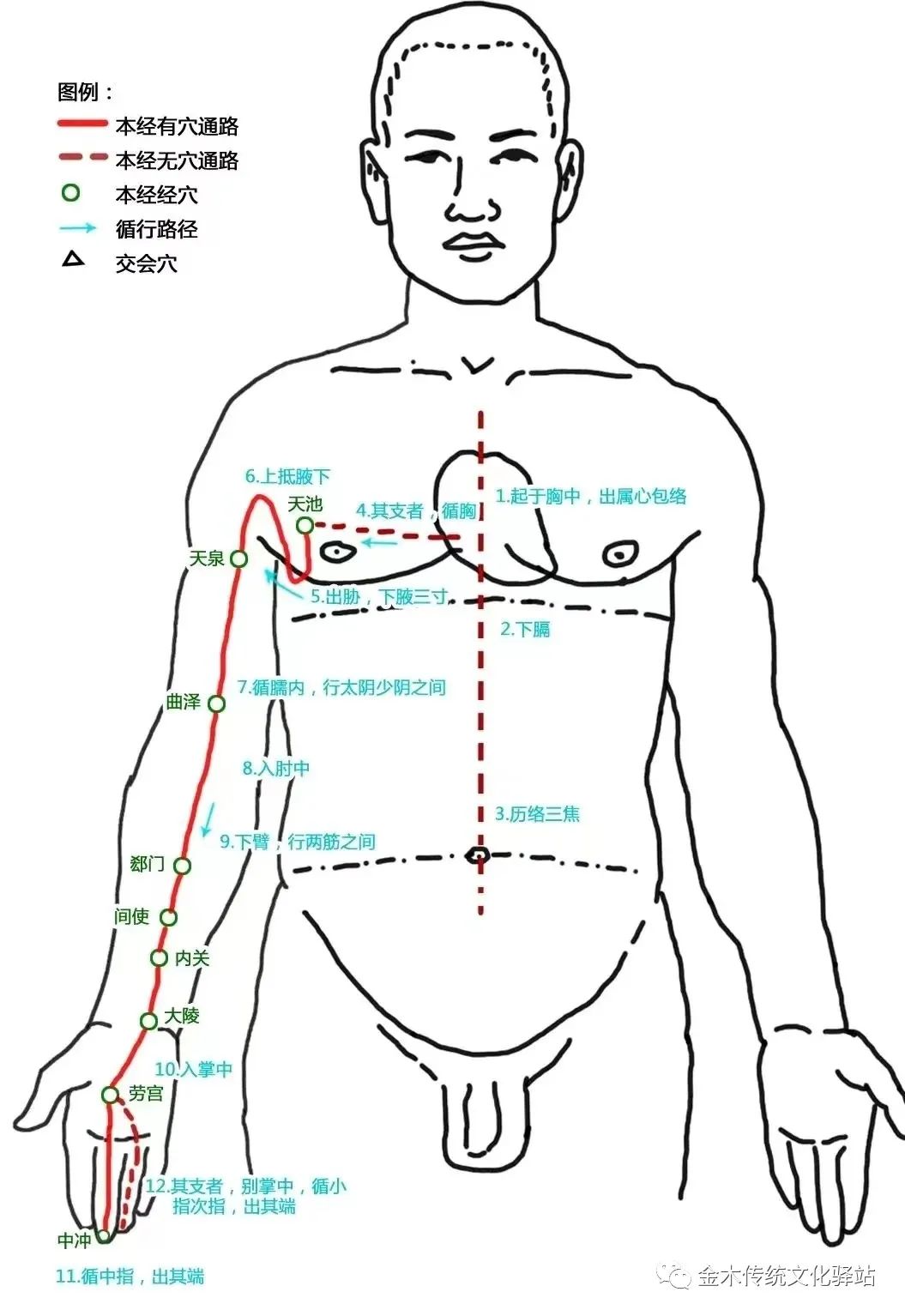

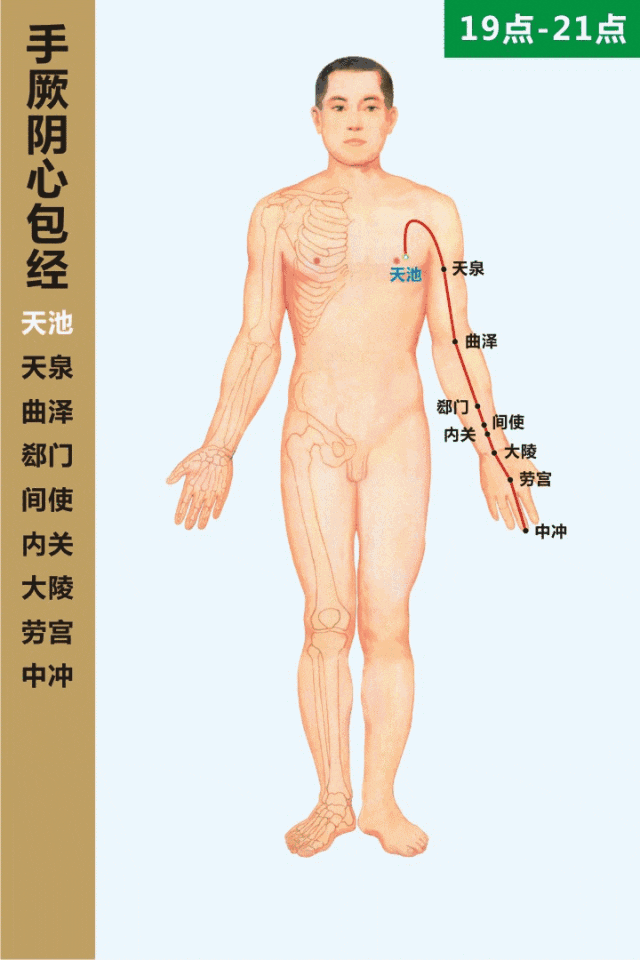
10. San Jiao Hand Shaoyang Meridian (三焦手少阳之脉) – 23 Points
“Ling Shu – Jing Mai”: The San Jiao Hand Shaoyang Meridian originates at the tip of the little finger, ascends between the two fingers, follows the outer wrist, exits between the two bones of the arm, ascends through the elbow, follows the outer shoulder, intersects after the foot Shaoyang, enters the diaphragm, spreads in the chest, disperses the pericardium, descends to the diaphragm, and belongs to the San Jiao.
Its branch emerges from the chest, ascends to the diaphragm, follows the neck, connects to the ear, and descends to the cheek.
Its branch enters the ear, exits in front of the ear, crosses the cheek, and reaches the inner corner of the eye.
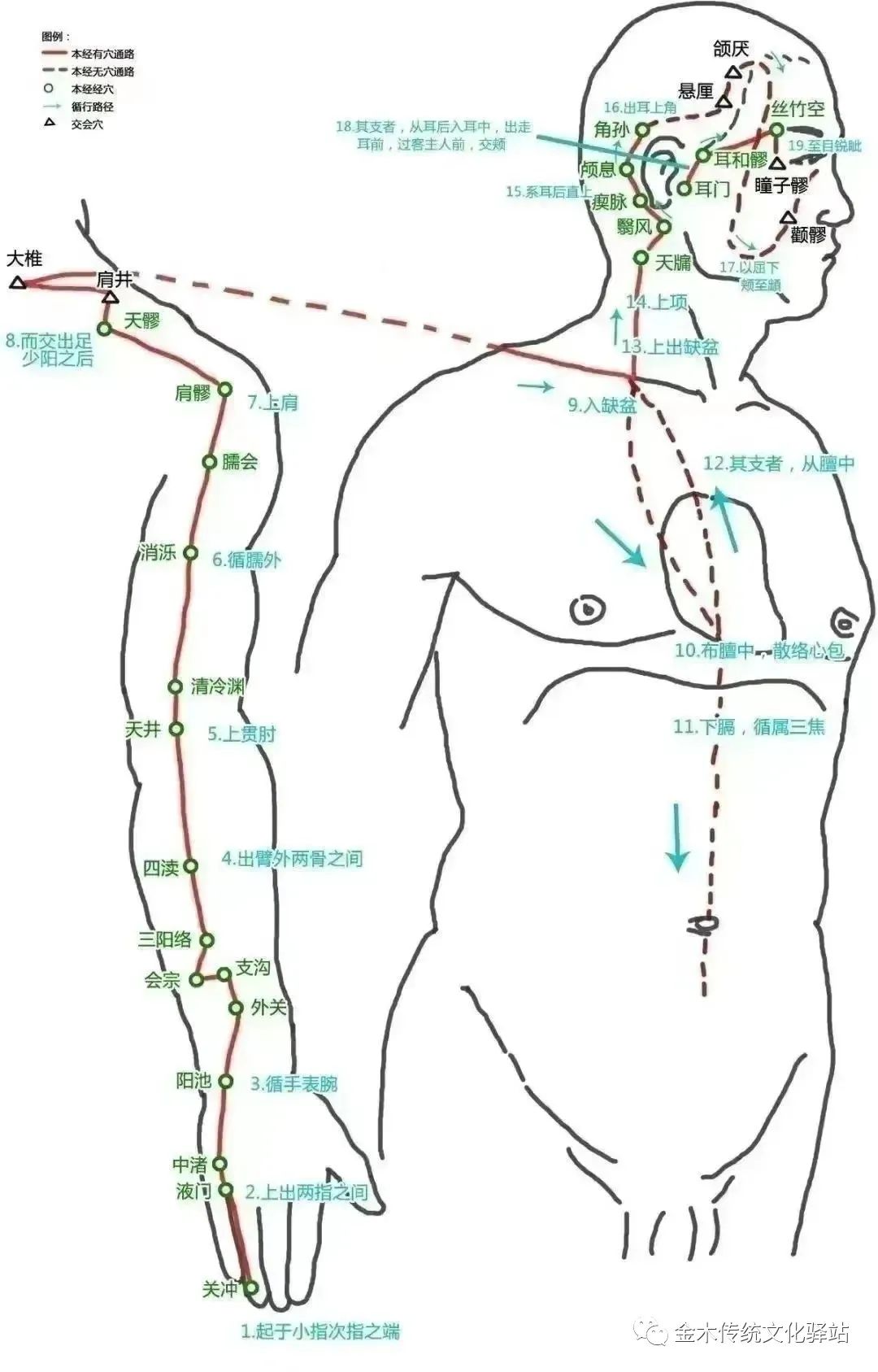

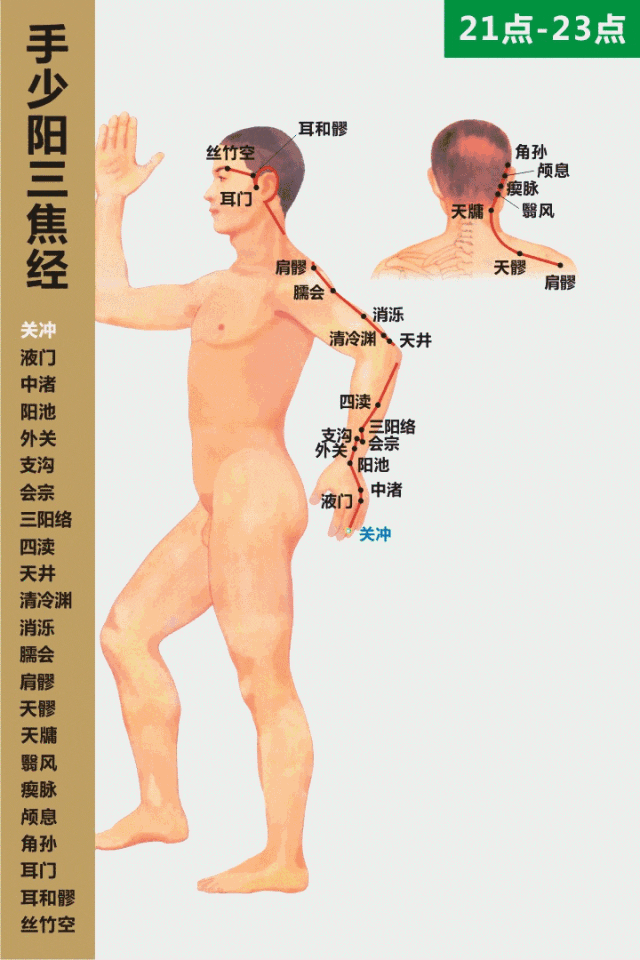
11. Gallbladder Foot Shaoyang Meridian (胆足少阳之脉) – 44 Points
“Ling Shu – Jing Mai”: The Gallbladder Foot Shaoyang Meridian originates at the inner corner of the eye, ascends to the head, descends behind the ear, follows the neck, travels in front of the hand Shaoyang, reaches the shoulder, intersects after the hand Shaoyang, and enters the diaphragm.
Its branch enters the ear, exits in front of the ear, and reaches the inner corner of the eye.
Its branch separates at the inner corner of the eye, descends to Da Ying, connects to the hand Shaoyang, reaches the cheek, descends to the neck, connects to the diaphragm, descends to the chest, penetrates the diaphragm, connects to the liver, belongs to the gallbladder, follows the ribs, exits at the Qi Jie, encircles the hairline, and horizontally enters the hip joint.
Its direct branch descends from the diaphragm, follows the chest, passes the ribs, and descends to the hip joint. It follows the Yang of the hip, exits at the outer margin of the knee, descends in front of the outer ankle, follows the foot bones, and enters between the little toe and the index toe, exiting at its tip.
Its branch separates at the top of the foot, entering between the big toe and the second toe, following the inner side of the big toe, exiting at its tip, and connecting to the nail.
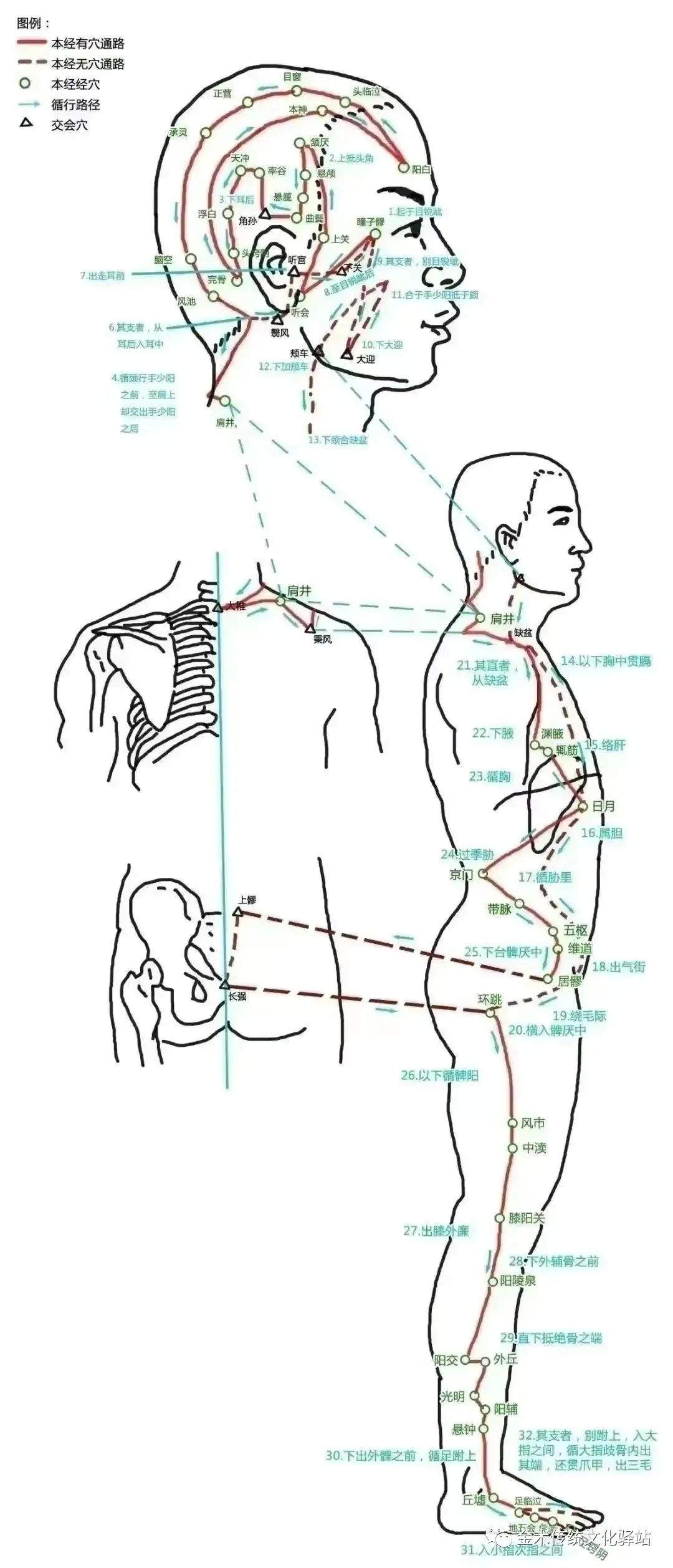
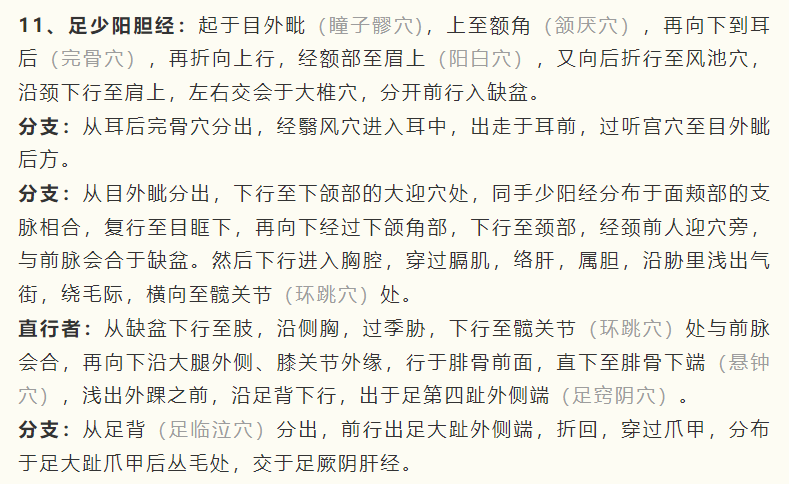
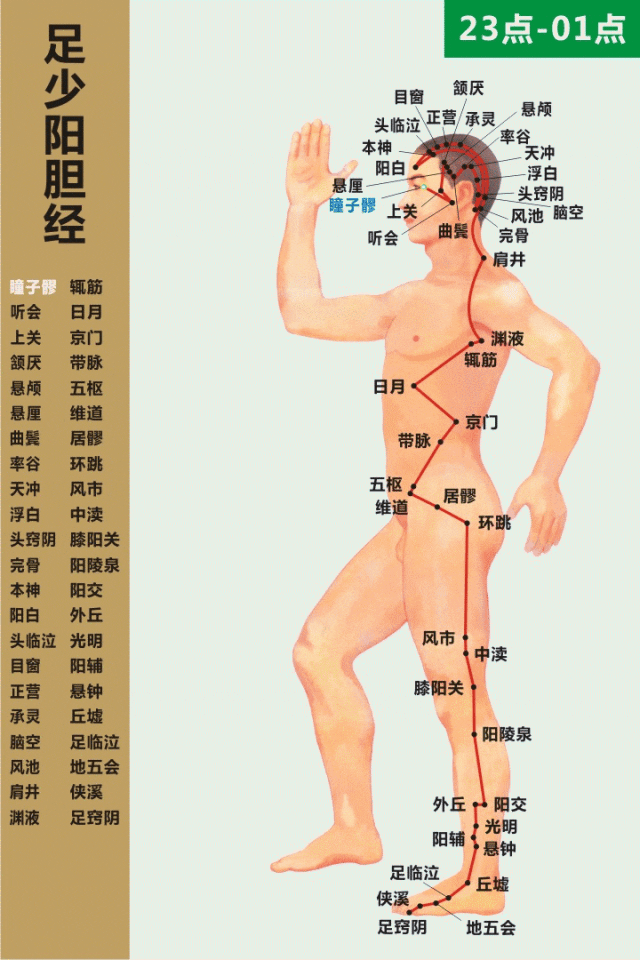
12. Liver Foot Jueyin Meridian (肝足厥阴之脉) – 14 Points
“Ling Shu – Jing Mai”: The Liver Foot Jueyin Meridian originates at the junction of the big toe, ascends along the outer margin of the foot, goes one cun away from the inner ankle, ascends eight cun, intersects after the Taiyin (太阴) point, ascends along the inner back of the knee, follows the inner thigh, encircles the genitalia, reaches the lower abdomen, connects to the stomach, belongs to the liver, connects to the gallbladder, ascends through the diaphragm, spreads across the ribs, follows the throat, ascends to the crown, and connects to the eye system, exiting at the forehead, meeting the Du Meridian at the crown.
Its branch emerges from the eye system, descends into the cheek, encircles the lips.
Its branch separates from the liver, penetrates the diaphragm, and ascends to the lung.


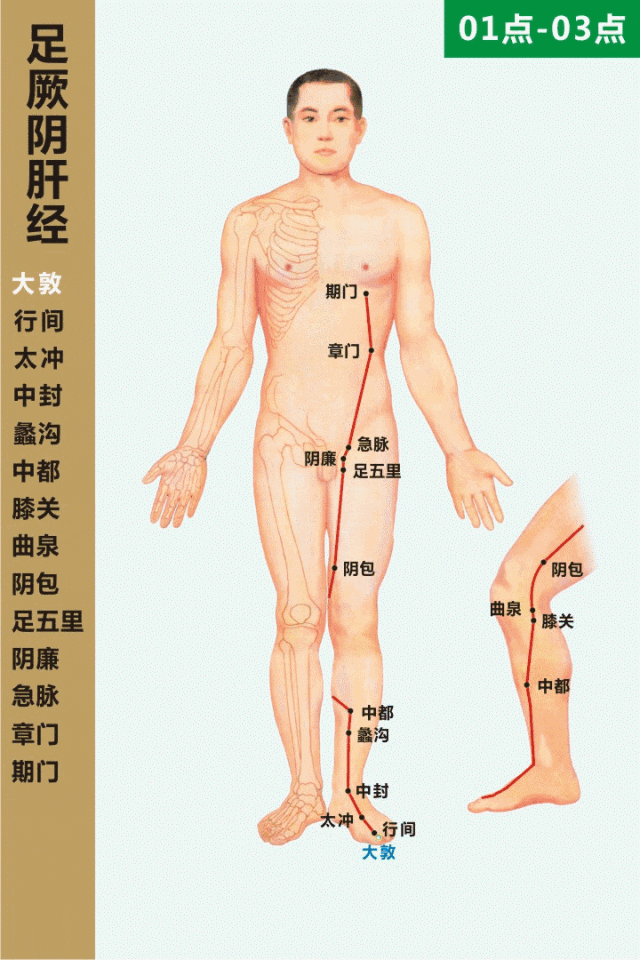
13. Ren Meridian (任脉) – 24 Points
“Nan Jing – Twenty-Eight Difficulties”: The Ren Meridian originates below the Zhongji (中极) point, ascends along the outer margin, follows the abdomen, reaches the Guan Yuan (关元), and ascends to the throat. (This is also mentioned in “Su Wen – Bone Hollow Theory” as “ascending to the jaw, following the face, and entering the eyes.”)
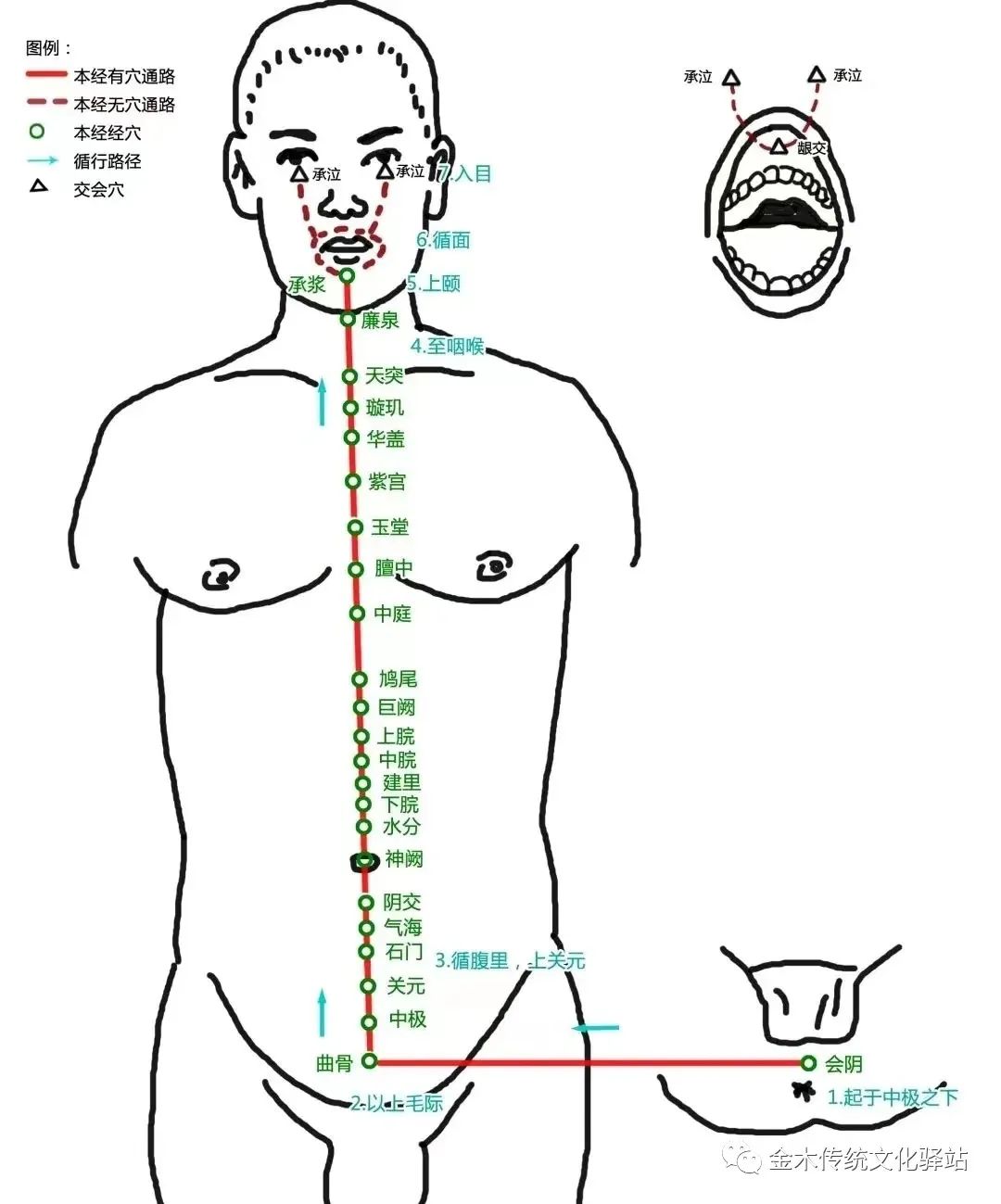
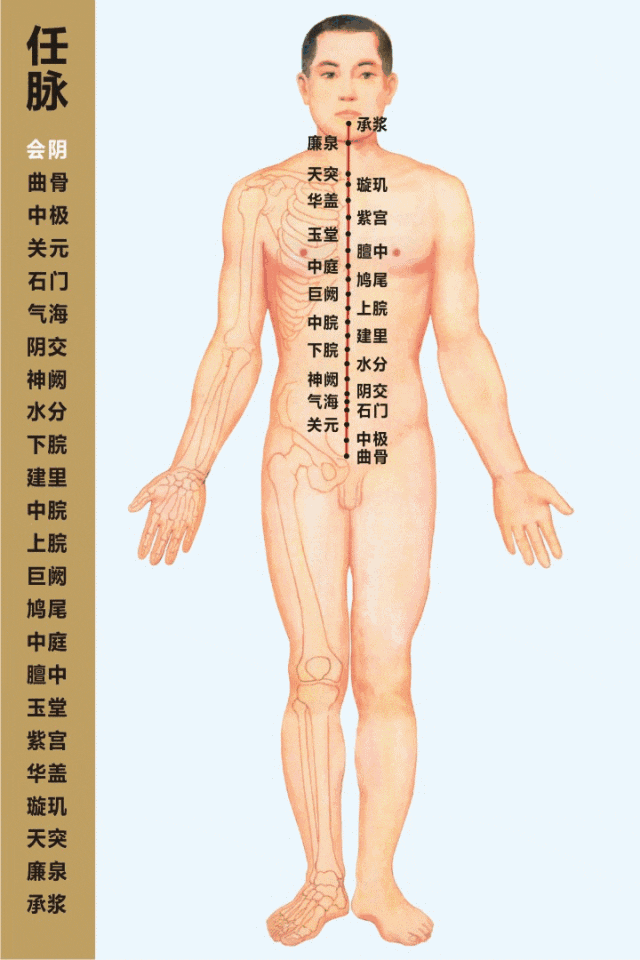
14. Du Meridian (督脉) – 29 Points
“Nan Jing – Twenty-Eight Difficulties”: The Du Meridian originates at the lower extreme of the spine, ascends along the back, reaches the Fengfu (风府), and enters the brain. (This is also mentioned in “Jia Yi Jing” as “ascending to the crown, following the forehead, and reaching the nose.”)
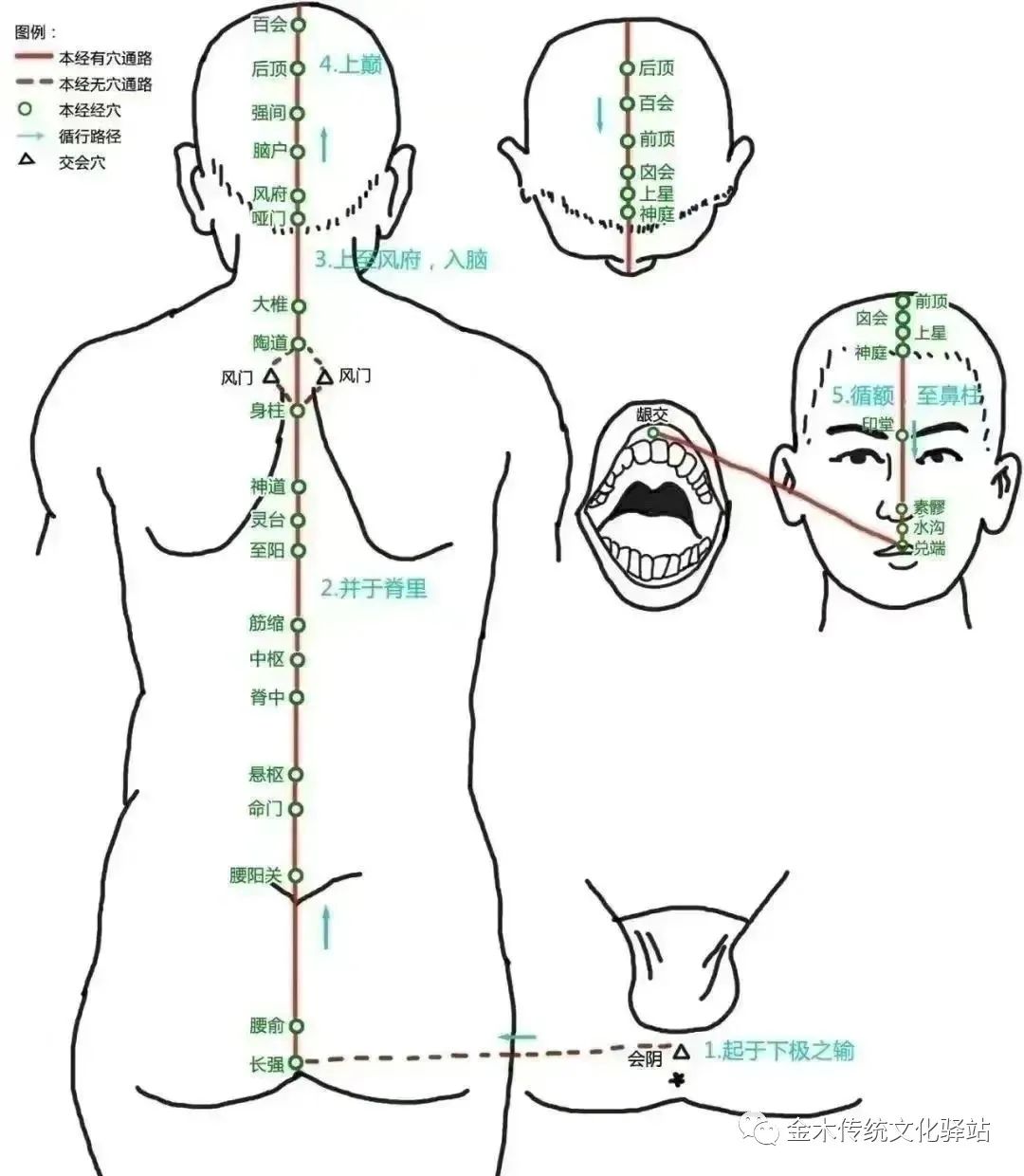
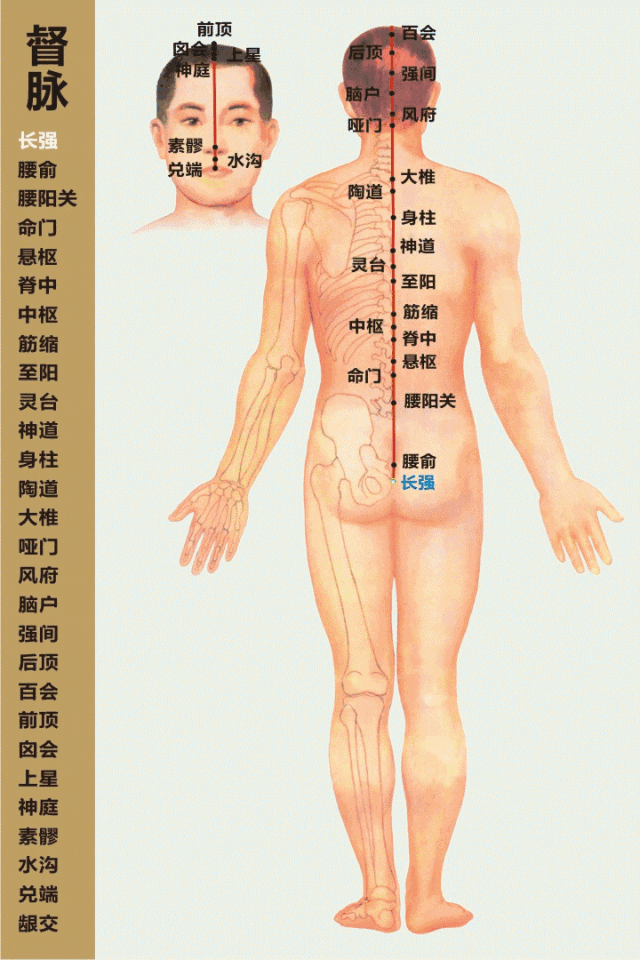 15. Chong Vessel (冲脉)“Ling Shu – Reverse and Follow the Fat and Thin”: The Chong Vessel is the sea of the five organs and six bowels, all of which are nourished by it. Its upper part emerges from the crown, permeates the Yang, and nourishes the essence; its lower part connects to the major branch of the Shaoyin, emerges from the Qi Jie, follows the inner thigh, enters the popliteal fossa, and travels along the Gàn (骭) bone, descending to the inner ankle and connecting to the lower part. Its lower part connects to the Shaoyin Meridian, permeates the three Yin; it travels along the foot, entering between the big toe and the second toe.“Su Wen – Bone Hollow Theory”: The Chong Vessel originates from the Qi Jie, connects to the Shaoyin Meridian, ascends along the navel, and reaches the chest to disperse.“Study of the Eight Extraordinary Vessels – Chong Vessel Chapter”: This vessel and the Ren Meridian both originate from the lower abdomen, ascending along the spine, serving as the sea of the meridians. Its external part ascends along the abdomen, reaching the throat, separating and connecting to the lips.”
15. Chong Vessel (冲脉)“Ling Shu – Reverse and Follow the Fat and Thin”: The Chong Vessel is the sea of the five organs and six bowels, all of which are nourished by it. Its upper part emerges from the crown, permeates the Yang, and nourishes the essence; its lower part connects to the major branch of the Shaoyin, emerges from the Qi Jie, follows the inner thigh, enters the popliteal fossa, and travels along the Gàn (骭) bone, descending to the inner ankle and connecting to the lower part. Its lower part connects to the Shaoyin Meridian, permeates the three Yin; it travels along the foot, entering between the big toe and the second toe.“Su Wen – Bone Hollow Theory”: The Chong Vessel originates from the Qi Jie, connects to the Shaoyin Meridian, ascends along the navel, and reaches the chest to disperse.“Study of the Eight Extraordinary Vessels – Chong Vessel Chapter”: This vessel and the Ren Meridian both originate from the lower abdomen, ascending along the spine, serving as the sea of the meridians. Its external part ascends along the abdomen, reaching the throat, separating and connecting to the lips.”
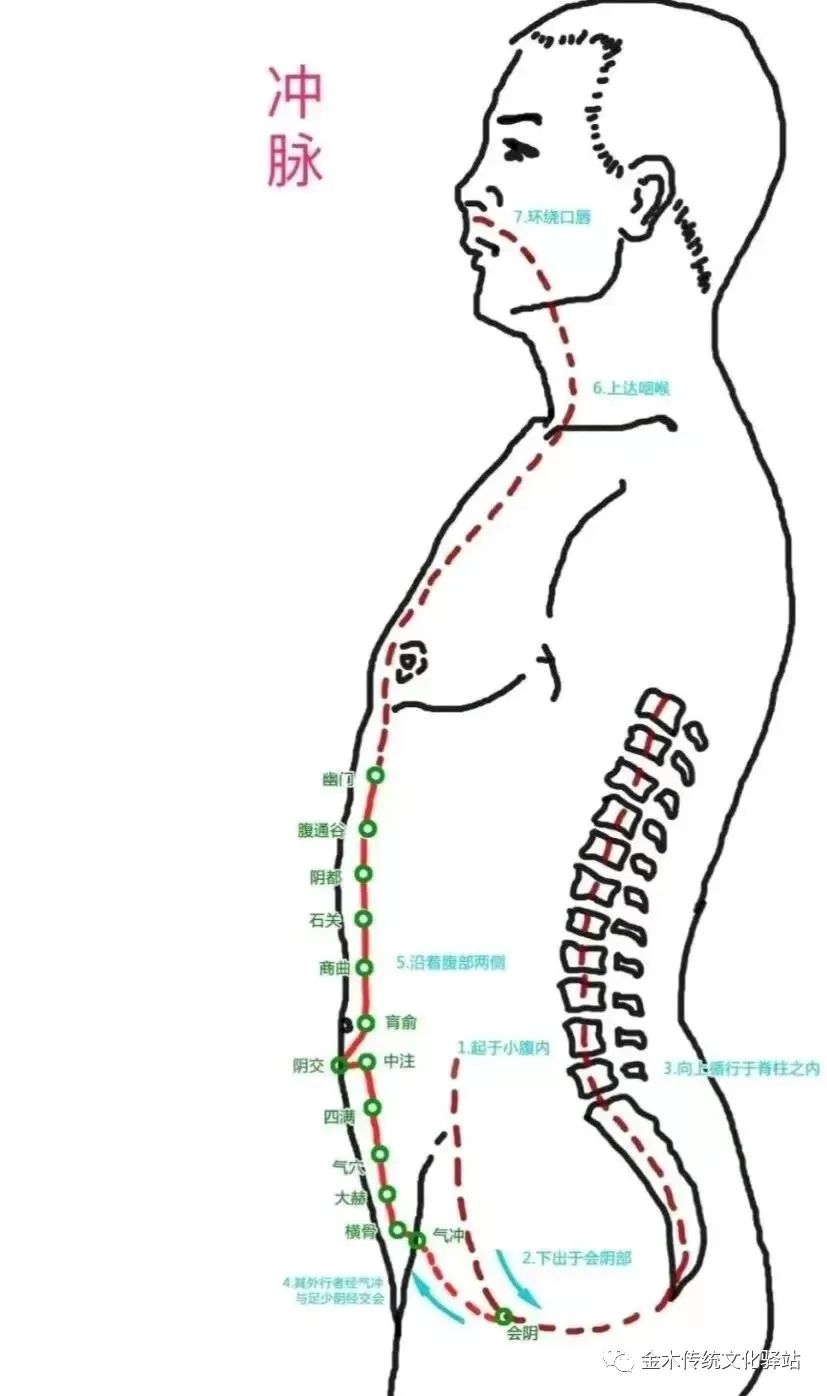
 Chong Vessel Meeting Points – 14 PointsMeeting points include Hui Yin (会阴) (Ren Meridian), Qi Chong (气冲) (Foot Yangming Meridian), Heng Gu (横骨), Da He (大赫), Qi Xue (气穴), Si Man (四满), Zhong Zhu (中注) (Foot Shaoyin Meridian), Yin Jiao (阴交) (Ren Meridian), Huan Yu (肓俞), Shang Qu (商曲), Shi Guan (石关), Yin Du (阴都), Tong Gu (通谷), You Men (幽门) (Foot Shaoyin Meridian), totaling 14 points.
Chong Vessel Meeting Points – 14 PointsMeeting points include Hui Yin (会阴) (Ren Meridian), Qi Chong (气冲) (Foot Yangming Meridian), Heng Gu (横骨), Da He (大赫), Qi Xue (气穴), Si Man (四满), Zhong Zhu (中注) (Foot Shaoyin Meridian), Yin Jiao (阴交) (Ren Meridian), Huan Yu (肓俞), Shang Qu (商曲), Shi Guan (石关), Yin Du (阴都), Tong Gu (通谷), You Men (幽门) (Foot Shaoyin Meridian), totaling 14 points. 16. Dai Vessel (带脉)“Ling Shu – Jing Bie Chapter Eleven”: The Dai Vessel is the correct pathway of the Foot Shaoyin, reaching the popliteal fossa, separating from the Taiyang and connecting, ascending to the kidney, reaching the fourteenth vertebra, and connecting to the Dai Vessel.“Study of the Eight Extraordinary Vessels”: The Dai Vessel originates from the lateral ribs of the foot Shaoyin, following the foot Shaoyang, encircling the body like a belt; it also meets the foot Shaoyang at Wu Shu (五枢) and Wei Dao (维道); totaling eight points.
16. Dai Vessel (带脉)“Ling Shu – Jing Bie Chapter Eleven”: The Dai Vessel is the correct pathway of the Foot Shaoyin, reaching the popliteal fossa, separating from the Taiyang and connecting, ascending to the kidney, reaching the fourteenth vertebra, and connecting to the Dai Vessel.“Study of the Eight Extraordinary Vessels”: The Dai Vessel originates from the lateral ribs of the foot Shaoyin, following the foot Shaoyang, encircling the body like a belt; it also meets the foot Shaoyang at Wu Shu (五枢) and Wei Dao (维道); totaling eight points.

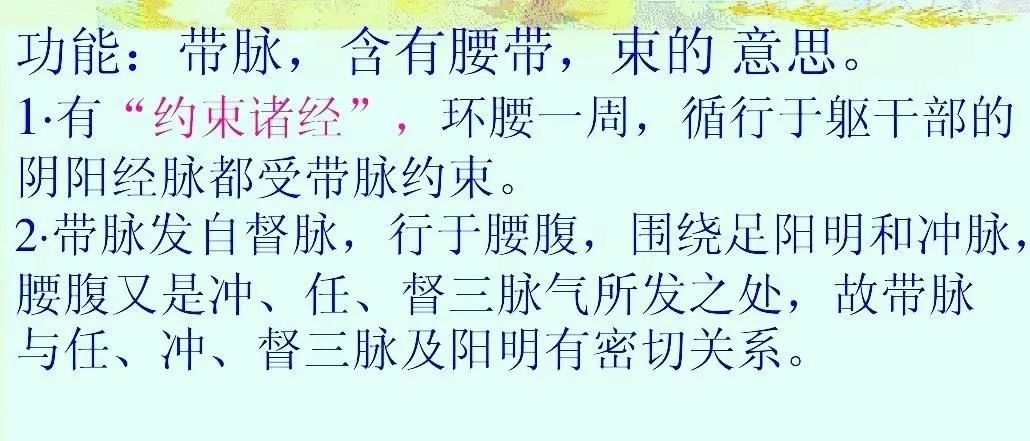
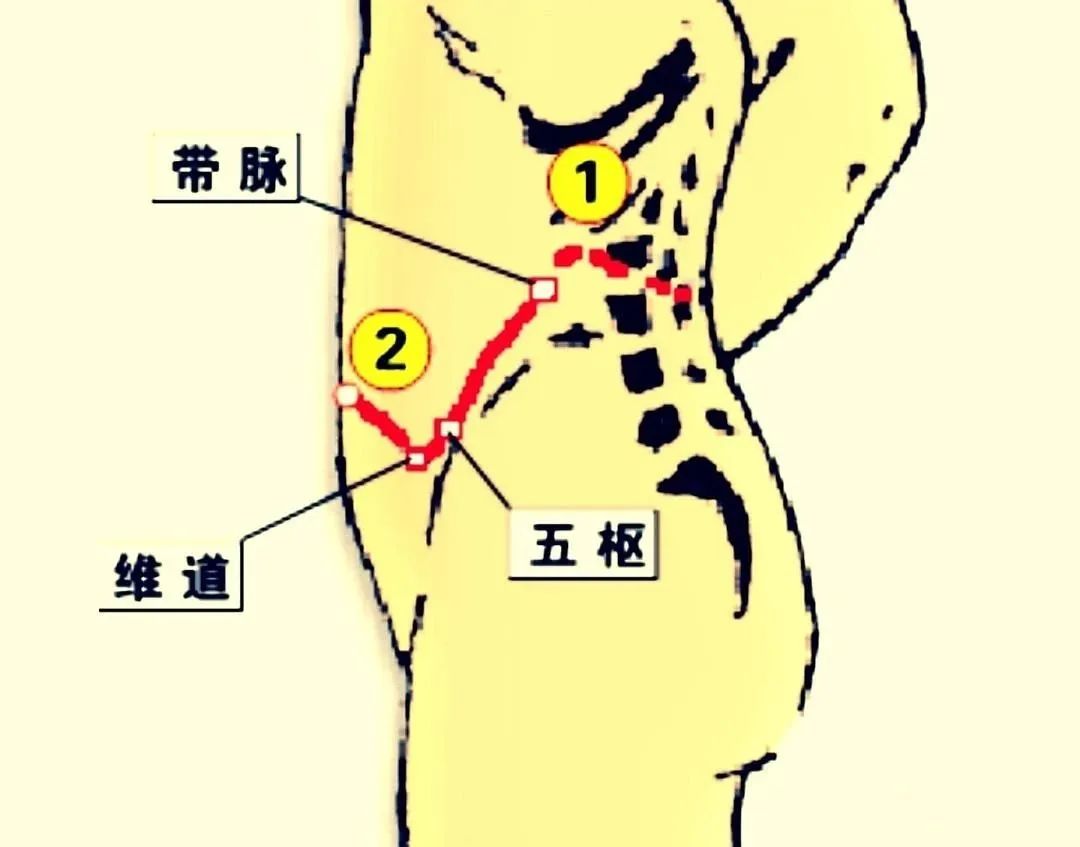 It emerges from the second lumbar vertebra (from the foot Shaoyin and foot Taiyang), horizontally encircling the waist below the eleventh rib, meeting the foot Shaoyang at Wu Shu and Wei Dao.
It emerges from the second lumbar vertebra (from the foot Shaoyin and foot Taiyang), horizontally encircling the waist below the eleventh rib, meeting the foot Shaoyang at Wu Shu and Wei Dao.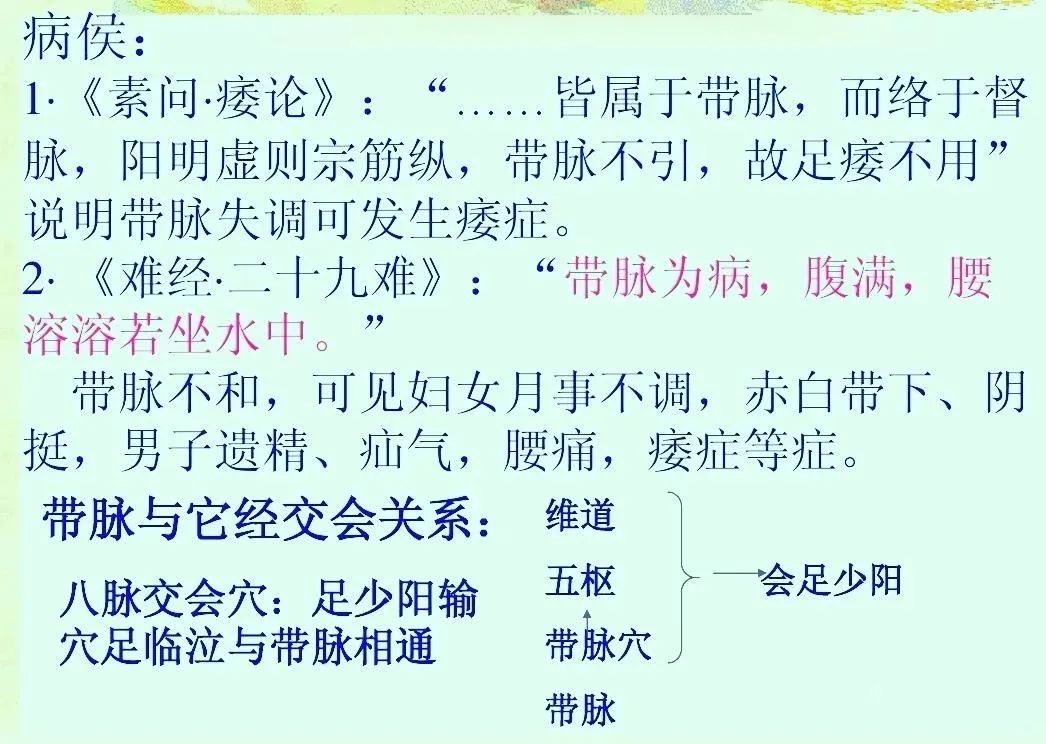
| Location of Points | Number of Points |
|---|---|
| Human Body Points | 405 Points |
| Other Points | 43 Points |
| Head and Face | 14 Points |
| Chest, Abdomen, and Back Points | 9 Points |
| Limbs Points | 20 Points |
| Twelve Meridians + Ren and Du Vessels | 362 Points |
| Lung Hand Taiyin Meridian | 11 Points |
| Large Intestine Hand Yangming Meridian | 20 Points |
| Stomach Foot Yangming Meridian | 45 Points |
| Spleen Foot Taiyin Meridian | 21 Points |
| Heart Hand Shaoyin Meridian | 9 Points |
| Small Intestine Hand Taiyang Meridian | 19 Points |
| Bladder Foot Taiyang Meridian | 67 Points |
| Kidney Foot Taiyang Meridian | 27 Points |
| Pericardium Hand Jueyin Meridian | 9 Points |
| San Jiao Hand Shaoyang Meridian | 23 Points |
| Gallbladder Foot Shaoyang Meridian | 44 Points |
| Liver Foot Jueyin Meridian | 14 Points |
| Ren Meridian | 24 Points |
| Du Meridian | 29 Points |
| Total | 362 Points |
Appendix
|
Other 43 Points |
|
|
Head and Face 14 Points |
1. Si Shen Cong (四神聪) 2. Yu Yao (鱼腰) 3. Tai Yang (太阳) 4. Er Jian (耳尖) 5. Qiu Hou (球后) 6. Shang Ying Xiang (上迎香) 7. Nei Ying Xiang (内迎香) 8. Jin Jin (金津) 9. Yu Ye (玉液) 10. Jia Cheng Jiang (夹承浆) 11. Qian Zheng (牵正) 12. Yi Ming (翳明) 13. Jing Bai Lao (颈百劳) 14. An Mian (安眠) |
|
Chest, Abdomen, and Back Points – 9 Points |
1. Zi Gong (子宫) 2. San Jiao Jiu (三角灸) 3. Ding Chuan (定喘) 4. Jia Ji (夹脊) 5. Wei Wan Xia Yu (胃脘下俞) 6. Pi Gen (痞根) 7. Yao Yan (腰眼) 8. Shi Qi Zui (十七椎) 9. Yao Qi (腰奇) |
|
Limbs Points – 20 Points |
1. Jian Qian (肩前) 2. Zhou Jian (肘尖) 3. Er Bai (二白) 4. Zhong Kui (中魁) 5. Da Gu Kong (大骨空) 6. Xiao Gu Kong (小骨空) 7. Yao Tong Dian (腰痛点) 8. Wai Lao Gong (外劳宫) 9. Ba Xie (八邪) 10. Si Feng (四缝) 11. Shi Xuan (十宣) 12. He Ding (鹤顶) 13. Bai Chong Wo (百虫窝) 14. Nei Xi Yan (内膝眼) 15. Dan Nang (胆囊) 16. Lan Wei (阑尾) 17. Nei Ankle Tip (内踝尖) 18. Wai Ankle Tip (外踝尖) 19. Ba Feng (八风) 20. Du Yin (独阴) |
Disseminating TCM health knowledge, promoting Chinese traditional culture, sharing health concepts, and conveying care, passing health knowledge and traditional culture to more friends…
People are great because of their dreams; we are different because of our love.
Liu Ling Ning: 182 7127 1941 or (WeChat ID)
Yang Shun Song: 138 7171 7447 or (WeChat ID)


